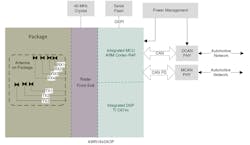Automotive Radar with Integrated Antenna Unlocks New Auto Applications
Members can download this article in PDF format.
Single-chip radars have been available for several years now and their use in automotive applications continues to grow. One recent improvement is expected to further increase their adoption—integrating the antenna with the IC, creating a much smaller overall package. The smaller size lets engineers put these sensors into ever-smaller spaces. In addition, modern versions of the radar sensors have brought about a whole new set of applications that involve controlling automotive functions with hand gestures.
Single-Chip Radar
IC radars are called radar sensors. They operate in the millimeter-wave (mmWave) bands like 76 to 81 GHz and 61 to 64 GHz. Most devices contain multiple transmitters and receivers that use frequency-modulated continuous-wave (FMCW) signals with a chirp format. The IC contains a full digital signal processor (DSP) to generate, receive, and process the return signals.
For the most part, the device is fully self-contained except for the antenna. In the past, that was left to the designer. Most sensors used PCB antennas that occupied a significant amount of PCB space. A new generation of radar sensors packages the IC and an integrated antenna, producing an antenna-on-package (AoP) module that’s considerably smaller than other arrangements. It also allows non-RF engineers to design with the new sensors without knowledge of mmWave antenna design.
One product with this capability is Texas Instruments’ AWR1843AOP. Integrating four transmitters and three receivers, the sensor is designed to operate at 77 GHz although it has a total range of 76 to 81 GHz. Bandwidth is 4 GHz. Each transmitter can emit up to 16 dBm EIRP; the receivers have a noise figure of 10 dB. These radios are operated by an Arm Cortex-R4F MCU. Also on-chip is a C674 DSP to process the received signals.
As for the antenna, it’s programmable in the transmit path using the internal phase shifters and amplitude controllers, making it a phased array that allows for beamforming and control of the transmit field of view (FoV). The IC, packaged in a 15- × 15-mm BGA, has plenty of I/O ports, including CAN, I2C, SPI, UART, and GPIOs.
The figure shows the components of the chip in an automotive application.
New Applications
The AWR1843AOP makes it possible to provide greater detail in recognizing objects around the vehicle. Auto manufacturers are continuing to build in more advanced driver-assistance system (ADAS) features that can recognize larger objects, but the AWR1843AOP provides finer-grain details.
The device provides near-field detection capability that enhances detection of smaller objects. An example is a sensor that indicates if a car door can be opened or if it’s blocked in some way. It’s able to detect lower objects such as a nearby curb, or even detect partially “transparent” objects like bicycles or grocery carts. Other uses include trunk or back-door open or closed condition, blind-spot detection, lane-change detection, cross-traffic alert, and parking assistance.
The beauty of this IC is its small size, which allows it to be placed in ever-smaller locations like door handles, rocker panels, or B pillars. Overall, the radar sensor is far more precise and reliable that other sensors like ultrasonic, time of flight or video cameras.
Finally, this device proves useful in manufacturing, where object detection of automatic vehicles or robot arm positions are a common issue. There are dozens of uses in factories and buildings.
Implementing Hand-Gesture Control in Vehicles
Another and somewhat unexpected application for these radar chips is hand-gesture control. Gesture detection gives drivers a new way to control in-cabin climate, lighting, windows, infotainment systems, and other systems with a wave of the hand. With TI mmWave radar technology, the devices are able to detect multiple gestures such as swipes left to right, right to left, and up or down without the use of touchscreens, buttons, or knobs. With ever-more devices to control in a vehicle today, gesture detection minimizes driver distraction.
A special radar sensor has been created to implement these features. Called the AWR6843AOP, this sensor enables high-accuracy gesture detection even through materials, and its small form factor enables placement in flexible positions within the vehicle.
The AWR6843AOP is similar to the AWR1843AOP, but it’s a bit more limited and more focused on the gesture application. It operates in the 60-GHz mmWave band, and many features are the same as the AWR1843AOP. The integrated AoP feature makes it small enough to place in the dashboard or other locations around the interior.
FoV of the AWR6843AOP is programmable to optimize the application. The radar can see through materials, including people and other obstacles. In addition, the sensor isn’t affected by light, a problem with other sensors. You can use it to detect how many people are in the vehicle and where. No doubt, some additional clever uses will be developed.
These two radar sensors will help automotive engineers reassess interior and exterior design to create a safer, useful, and more convenient vehicle. The AoP feature eliminates the difficult design and testing of mmWave antennas, and the resulting smaller footprint lets the sensor be placed in smaller locations. And development boards and software are available to speed design.
About the Author

Lou Frenzel
Technical Contributing Editor
Lou Frenzel is a Contributing Technology Editor for Electronic Design Magazine where he writes articles and the blog Communique and other online material on the wireless, networking, and communications sectors. Lou interviews executives and engineers, attends conferences, and researches multiple areas. Lou has been writing in some capacity for ED since 2000.
Lou has 25+ years experience in the electronics industry as an engineer and manager. He has held VP level positions with Heathkit, McGraw Hill, and has 9 years of college teaching experience. Lou holds a bachelor’s degree from the University of Houston and a master’s degree from the University of Maryland. He is author of 28 books on computer and electronic subjects and lives in Bulverde, TX with his wife Joan. His website is www.loufrenzel.com.

